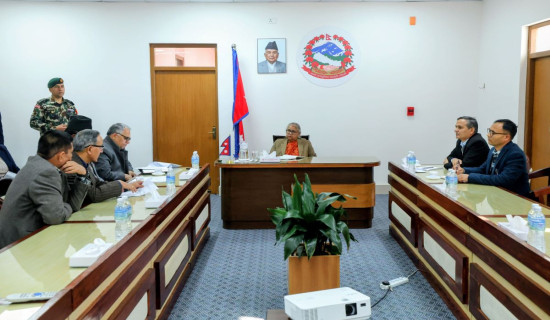- Thursday, 18 December 2025
Prepare Against Monsoon Disasters
Monsoon season is arriving in Nepal in a couple of days. It is time for the three-tier governments to prepare themselves for responding to various rain-induced disasters. The rainy season, however, is a boon for the country’s agriculture sector which still lacks sufficient irrigation facilities. This is the main season for farmers to plant paddy, a major cereal crop in the country. Paddy production becomes high when a lot of rainfall is recorded in monsoon. Thus, rains bring a lot of cheers to farmers. But the monsoon proves to be bane when the nation witnesses incessant torrential rains. Such downpours wreak havoc on the lives of people and properties throughout Nepal every year. The nation records many human casualties and destruction of private and public assets and structures during this period. Several important development projects, including the Melamchi Water Supply Project, have suffered a big setback due to floods and landslides. Such projects have incurred an irreparable loss.
Bearing all this in mind, government authorities come up with plans and strategies each year to respond to the calamities by carrying out rescue operations and providing relief to the victims and their family. They also forward reintegration and resettlement plans for those rendered homeless due to such catastrophes. But it is saddening to mention that such plans are not found being implemented in an effective manner. Because of this, the disaster-hit are forced to keep going through hardships for a long time. One of main reasons for an ineffective enforcement of plans is a lack of proper coordination and collaboration among the government bodies, the organisations working in the areas of response and recovery, communities and individuals. They could respond to calamities and help people recover from the impacts of probable, impending and current tragedies only when they have developed preparedness.
Fragile geology
Many parts of Nepal are considered geologically fragile. So, the nation must have a preparedness plan that makes necessary arrangements in advance to ensure timely, effective and appropriate responses to definite potential hazardous events or imminent disaster situations. Growing human activities are responsible for the country’s increased susceptibility to monsoon disasters. Haphazard use of dozers for constructing roads and opening tracks, encroachments of river banks, mining and tunneling seem to have emerged as the key factors causing landslides. Deforestation is also equally responsible for rising risk of landslides because it reduces slope stability and increases vulnerability to soil erosion. Extreme weather events like heavy rainfalls in certain areas due to climate change have also contributed to monsoon disasters.
It is apparent that preparedness is founded on a comprehensive analysis of disaster menaces and proper linkages with the information dissemination system, especially early warning system. Preparedness also comprises of numerous other activities like contingency planning, storing equipment and supplies, arrangements for coordination, evacuation and relevant training and field exercises. These arrangements need to be supported by institutional, legal and budgetary dimensions in order to cope with disaster situations well. Installing early warning systems in more places could be of great help for preventing disaster situations.
Last year, as many as 92 persons lost their lives to rain-induced disasters. However, such calamities caused huge damage to private and public properties, rendering hundreds of people homeless. However, the nation did not record as much rainfall as forecast by the Department of Hydrology and Meteorology (DHM). The weather forecasting body has projected that the country may witness 35-55 per cent more rainfall during this summer than the average. If the forecast comes true, rain-induced disasters is likely to become more damaging. This really calls for making better disaster preparedness. The National Disaster Risk Reduction and Management Authority (NDRRMA) under the Ministry of Home Affairs has estimated that the monsoon disasters may affect some 412,000 households nationwide. Nearly 83,000 households of them are anticipated to remain affected directly. And about 1.8 million people are likely to be in need of rescue and relief services.
According to the projection made by the NDRRMA, the Koshi Province may become the most affected among provinces during this summer. An estimated 22,000 houses in the province will remain affected directly. An estimated 500,000 people from nearly 113,000 households may be affected in one way or the other by the monsoon disasters like floods and landslides. The Madhes Province is projected to be in the second position in terms of monsoon disaster. As many as 430,000 people belonging to 98,000 families are expected to be affected there. The low lands in the Terai districts are more susceptible to inundation than others. The Lumbini Province will become the third most monsoon-hit province.
Coordination
A number of places adjoining Indian borders are at risk of being waterlogged in summer as the southern neighbour has constructed roads, dams and railways. Consequently, many Nepali settlements are vulnerable to inundations. As this is a serious issue, the Nepal government must take the initiative to resolve it without delay.
The Karnali Province and Sudurpaschim Province are also quite vulnerable to rain-induced calamities. Many parts of these provinces have suffered cracks during November 2023 earthquake. Many quake-hit are still bound to live in cracked houses and under tented camps owing to their failure to reconstruct their houses. The probable monsoon disasters may cause additional suffering to them. It is necessary to strengthen inter-agency coordination to respond to disasters effectively. As the local governments are the closest to the people, it could play an important role in distributing relief materials. They also get the disaster-related information immediately. Therefore, they must be equipped with the required means and resources for dealing with disasters.
(The author is a former deputy executive editor of this daily.)
















